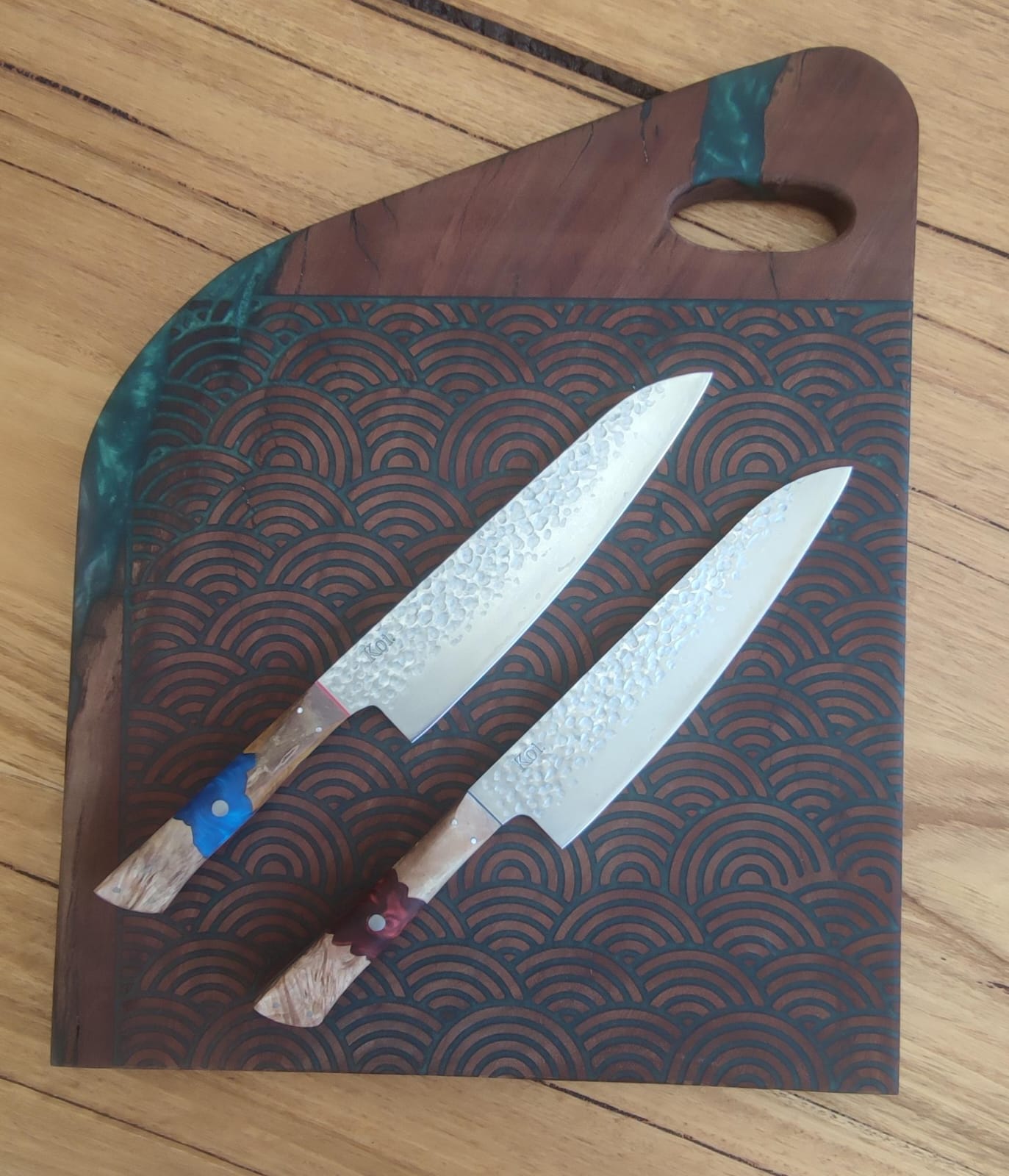Today, we embark on a journey to unravel the mystique of two exceptional Japanese knives: the Gyuto and the Santoku.
As your culinary fellows, understanding the subtlety between these blades is key. Beyond being kitchen tools, they are an extension of your artistry.
In this exploration, we'll delve into their histories, shared traits, and distinctive features. By the end, you'll differentiate between them but appreciate the craftsmanship behind each slice.
History of Gyuto and Santoku Knives
Gyuto: Originating from 19th-century imports from Germany or France, designed primarily for meat handling.
Santoku: A post-WWII Japanese invention based on the Nakiri knife traditionally specialised for vegetables.
Grasping their origins sheds light on the nuanced design distinctions that distinguish these knives.
Uses of Gyuto and Santoku Knives
Gyuto: Excels in all-encompassing kitchen duties, seamlessly transitioning from slicing to chopping.
Santoku: Adeptly handles cutting, slicing, and chopping, making it the go-to for diverse kitchen endeavours.
Their adaptability renders them indispensable, embodying the essence of an actual multi-purpose knife.
Similarities between Gyuto and Santoku
- Both epitomise versatility, negating the need for an arsenal of specialised blades.
- Designs feature a wider heel transitioning to a sharp tip, facilitating efficient chopping and precise cutting.
- Materials, including carbon and stainless steel, echo similarities, ensuring robust performance.
Differences between Gyuto and Santoku
Gyuto: Originating from Germany or France, designed for meat handling, boasting a more curved edge profile and a sharper tip.
Santoku: Emerges from the Nakiri, prioritising vegetables with its turned-down spine, exhibiting a sheep's foot blade.
- Variances in blade length, with Gyuto extending beyond 11.8 inches and Santoku typically below 7 inches, address spatial constraints.
Individual preferences play a pivotal role in choosing between these culinary companions.
Gyuto and Santoku Types We Make
Gyuto
Wood and Resin Handle (Partial Tang)
Our Gyuto knives are crafted precisely, offering a unique combination of a wooden and resin handle, providing a comfortable grip and a touch of aesthetic elegance. The partial tang design ensures a balanced feel, making it ideal for intricate tasks in the kitchen.
Yokohama Gyuto (Full Tang)
For those seeking the pinnacle of Gyuto craftsmanship, our Yokohama Gyuto boasts a full tang design. This means the blade extends through the handle, providing unmatched stability and control. It's a professional's choice, perfectly blending form and function.
Rainbow Gyuto (Full Tang)
In our Rainbow Gyuto, we've combined artistry with functionality. The full tang construction ensures durability, and the vibrant G10 rainbow handle adds a burst of colour to your kitchen.
Santoku
Wood and Resin Handle (Partial Tang)
Our Santoku knives marry functionality with beauty. The wood and resin handle with a partial tang offers a comfortable yet controlled grip, making it a versatile companion in the kitchen.
Yokohama Santoku (Full Tang)
Step into the world of precision with our Yokohama Santoku. The full tang design enhances the knife's balance and strength, transforming your culinary experience. It's more than a knife; it's a reliable partner in your cooking journey.
Rainbow Santoku (Full Tang)
Dive into the vibrant culinary world with our Rainbow Santoku. The full tang design ensures durability, while the G10 rainbow handle adds a touch of personality. It's a knife that performs and makes a style statement in your kitchen.
Detailed Descriptions of Select Gyuto Models
Original Gyuto ("Cow Sword")
Crafted with pride, our "Cow Sword" Gyuto stands as a testament to our commitment to culinary excellence.
Materials Used
Forged from high carbon VG10 67-layer Damascus Japanese steel, this Gyuto blends artistry with functionality. The handle, sourced from McLaren Vale's hardwoods, adds a touch of local character.
Design Features
With a 210mm cutting length, it's an all-purpose marvel. The handle, infused with resin for durability, reflects the unpredictability and uniqueness of nature. No two handles are alike.
Specifications
- Blade Length: 210mm
- Overall Length: 360mm
- Blade Thickness: 2.2mm
- Weight: 226g
- HRC: 60-61
Gyuto Yokohama Knife
For versatility in the kitchen, embrace the Yokohama Gyuto – a harmonious blend of form and function.
Materials Used
Featuring a G10 handle and VG10 Japanese steel, this Gyuto marries comfort with precision. The VG10 steel ensures a lasting razor-sharp edge.
Design Features
With a broad and curved blade, it facilitates a smooth rocking motion, making it ideal for various cutting tasks. The G10 handle ensures a comfortable grip.
Specifications
- Blade Length: 210mm
- Overall Length: 360mm
- Blade Thickness: 2.8mm
- Weight: 242g
Rainbow Collection Gyuto
Our remastered classic, the Rainbow Collection Gyuto, brings vibrant aesthetics to your culinary experience.
Materials Used
Forged from high carbon VG10 67-layer Damascus Japanese steel, it ensures exceptional edge retention. The G10 rainbow handle, inspired by the beauty of rainbows, adds a splash of color to your kitchen.
Design Features
With a 210mm cutting length and a new ergonomic G10 scale handle, it harmonizes aesthetics with practicality, thriving in both professional kitchens and homes.
Specifications
- Blade Length: 210mm
- Overall Length: 360mm
- Blade Thickness: 2.2mm
- Weight: 226g
- HRC: 60-61
Choose the Gyuto that resonates with your culinary spirit, each a unique masterpiece in its own right.
Detailed Descriptions of Select Santoku Models
Original Santoku ("Three Virtues")
Crafted with the essence of Japanese culinary tradition, our Original Santoku embodies the "Three Virtues" – slicing, dicing, and chopping.
Materials Used
Precision is paramount. This Santoku boasts high-carbon AUS10 67-layer Damascus Japanese steel, ensuring durability and a razor-sharp edge.
Design Features
The ergonomic handle, carved from Australian hardwood, offers a comfortable grip. Every handle is unique, a testament to the unpredictability of nature.
Specifications
- Blade Length: 185mm (7.28")
- Overall Length: 340mm (13.38")
- Blade Thickness: 1.6mm (0.062")
- Weight: 160g (5.64oz)
- HRC: 58-60
Santoku Yokohama Knife
Meet the Santoku Yokohama – a versatile kitchen companion designed for precision and style.
Materials Used
Forged from high-quality VG-10 Japanese steel, this knife promises exceptional sharpness. The G10 handle ensures both durability and a sleek aesthetic.
Design Features
The broad blade with a rounded tip allows for efficient slicing and dicing. Its comfortable G10 handle ensures a secure grip during extended kitchen sessions.
Specifications
- Blade Length: 185mm (7.28")
- Overall Length: 340mm (13.38")
- Blade Thickness: 1.6mm (0.062")
- Weight: 244g (8.61oz)
Rainbow Collection Santoku
Adding a burst of color to your kitchen, the Rainbow Collection Santoku marries aesthetics with functionality.
Materials Used
This Santoku is a visual delight, featuring a G10 rainbow handle paired with VG10 Japanese Damascus steel for a striking and resilient combination.
Design Features
Enjoy the robustness of a full-tang steel handle, finely balanced for precise control. The Rainbow Santoku elevates your culinary experience.
Specifications
- Blade Length: 210mm (8.26")
- Overall Length: 360mm (14.17")
- Blade Thickness: 2.2mm (0.086")
- Weight: 226g (7.23oz)
- HRC: 60-61
Choose a Santoku that aligns with your culinary aspirations; choose tradition with modernity for a genuinely exceptional kitchen experience.




